Description
Blue-cheeked AmazonDistribution / Range: This rare species is found in northeast South America; specifically in south-east Venezuela (Bolívar with an isolated record in Amazonas), north Guyana, north-east Suriname and north-east French Guiana. There are reports from Pará and Amapá, Brazil, where its occurrence seems probable, but there are no conclusive records.They inhabit humid forests and cloud-forest in the lower subtropical zone but are known as savanna woodlands in Venezuela. This species occurs up to 1,700 m in Venezuela and 560 m in Guyana.There are some seasonal movements most likely in response to food availability, from interior to coastal Suriname from July to August.The numbers of this species have declined as a result of trapping for food and pet trade as well as habitat loss, particularly in the Gran Sabana region of Bolívar and parts of coastal Guianas.
Description:
The Blue-cheeked Amazon Parrot averages 13.3 – 14.4 inches (~ 34 – 36 cm) in length (including tail) and weighs around 16.8 – 21 oz (480 – 600g).
The plumage is mostly green. It has blue cheeks from around the eye to the neck (less on young). They have a yellow-orange wing speculum, a yellowish crown, and orange lines (the region between the eye and the bill on the side of a bird’s head). The bill is grey with pink/red at the base of the upper bill. The eye rings are grey and the irises are orange/red.
Males and females look alike.
Juveniles look like adults but duller. The forehead and lores are dull yellow. The crown and occiput are green. The lower cheeks to ear coverts (feathers covering the ears) are green, slightly washed blue. There is less yellow on the outer secondary (wing) feathers. The bill is pale pink-tinged grey. The irises are brown and the eye rings are grey/white.
Blue-fronted Amazon Parrot
Blue-fronted Amazons average 14 – 15 inches (~35 cm) in length (from head to tail tip) and weigh 9.7 to 18 oz (275 to 510 grams) – the average being 14.1 to 15.2 oz (400 to 430 grams).
A wide range of color combinations has been produced. Some birds have no blue head feathers whatsoever; others have turquoise blue on their forehead or even the whole front of the bird (face, neck, and chest) is blue.
Most have yellow somewhere on their head or face; some have blue, a little white, and then yellow as head markings.
There are significant individual variations in both facial patterns and the amount of yellow/red to the “shoulder”. In one extreme, individuals with essentially no yellow to the head and entirely green “shoulder” are known from north-western Argentina.
Their beak is dark grey and their feet are grey.
Yellow-headed Amazon
The Yellow-naped Amazon averages 15 – 17 inches (38–43 cm) in length (including the tail). When excited all feathers of the neck and crown are raised, making the head appear double in size. They have a robust build, rounded wings, and a square tail. The body is bright green, with yellow on the head, dark scallops on the neck, red at the bend of the wing, and yellow thighs. The flight feathers are blackish to bluish violet with a red patch on the outer secondaries (shorter, upper “arm” feathers). The base of the tail also has a red patch, which is usually hidden. The outer tail feathers have yellowish tips. The bill is horn-colored, darker in immatures of the Belizean and Honduran subspecies. The eye-ring is whitish in Mexican birds and grayish in others. Males and females look alike.
These beautiful parrots are very intelligent and imaginative birds that are easily tamed as they enjoy human company. Therefore, they have grown to be very popular in the pet bird trade. They are considered very good talkers and singers.
Some become nippy and they may not be the right pet for the casual owner who doesn’t want to take the time to learn about parrot behavior and training. They are generally known to be noisy, thus they may not be suitable for individuals who are intolerant to noise. As is the case with most mid-size to large parrots, they can be destructive unless their energy is redirected at chewing toys, natural and non-toxic branches, and training on tricks.
Yellow-nape Amazon
Size: 12-15 inches (~35 cm)
Average weight: 480 to 680 grams
Their noticeable features are the green forehead and crown and a yellow band across the lower nape and hind neck. Some birds develop more yellow than others. Others don’t develop any yellow feathers at all. Yellow feathers may increase with maturity. Yellow feathers are also at the back of the neck (nape).
Dark gray beak with the base of the upper beak being somewhat lighter.
Grey feet.
Yellow Napes are loved for their intelligence, clown personality, and impressive talking and singing abilities, enhanced by their great sense of pitch. When talking, they display an amazingly human-sounding voice.
A healthy amazon parrot can live 50 to 60 years or even longer with good nutrition and care.
Some striking mutations of the Yellow Nape have occurred in aviaries, please refer to the below photos of beautiful Blue Mutation Yellow Napes.
Mealy Parrot
The Mealy Parrots are social and can usually be found in pairs or in large flocks. They are even known to interact with other parrots, such as macaws. They are usually quiet but can get loud at dusk and dawn.
These large amazon parrots average 38-41 cm (15 – 17 inches) in length, including the tail, and typically weigh between 540 to 700 g (19.01-24.64 ounces). Some Mealy parrots, however, are much larger than this.
Though less colorful than related parrot species, Mealy Parrots have a patch of blue, purple, or violet on the top of their heads. Along with the purple or blue crown, Mealy Parrot sometimes has patches of yellow on the head and usually has a green or mostly green body, with tail feathers being light green or lime at the tip. Some Mealy Parrots have a light blue/teal sheen to their green coat, and an undercoat of yellow, blue, purple, red, and/or teal. The beaks are usually yellowish. The eyes are a reddish-orange color, and underneath the eyes are usually white unfeathered rings.
Orange-winged Amazons
Orange-Winged Amazons are one of the smaller Amazons. They average 12 to 13 (~31 – 33 cm) in length, but some subspecies are as small as 10 inches. They weigh around 340 grams.
They are often confused with Blue-fronted Amazons. However, the orange-winged amazons are the only amazon with orange feathers in their wings, thus the name Orange-Winged Amazon. The color flight feathers in the Blue Fronts are red.
The plumage is mainly green with a blue forehead, some yellow on the crown, cheeks, and outer tail tips, and an orange speculum (= distinctive wing patch). The beak is horn-colored with a gray tip. The feet are pale grey / horn brown.
Males and females look alike.
challenges, such as excessive chewing – especially at certain stages in their life. They do discover their beaks as a method of “disciplining us” once they are out of the “baby stage” and they can generally be somewhat naughty, and it really is important to learn to understand them and to guide their behavior before an undesirable behavior has been established. Aggressive behavior is especially common in “hormonal” amazons. Undisciplined amazons will chew on electric wiring potentially causing house fires. They regard anything in your home as a “toy” that can be explored and chewed on; destroying items that you may hold dear or are simply valuable.
Even a young bird that has not been neglected and abused requires proper guidance; this becomes even more challenging when it involves a rescued bird that may require rehabilitation.

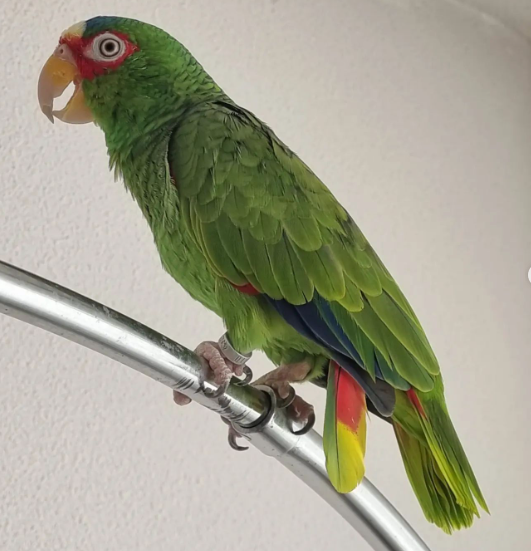
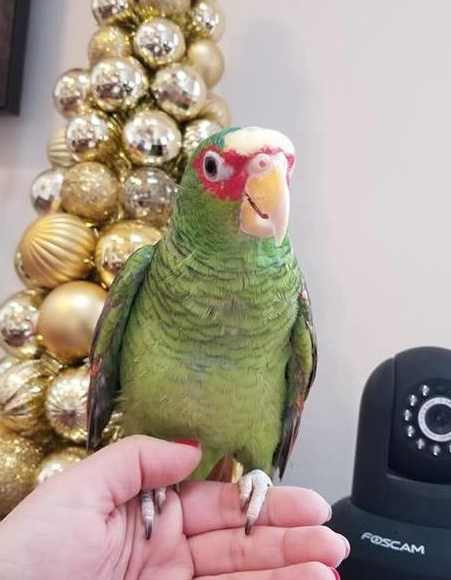

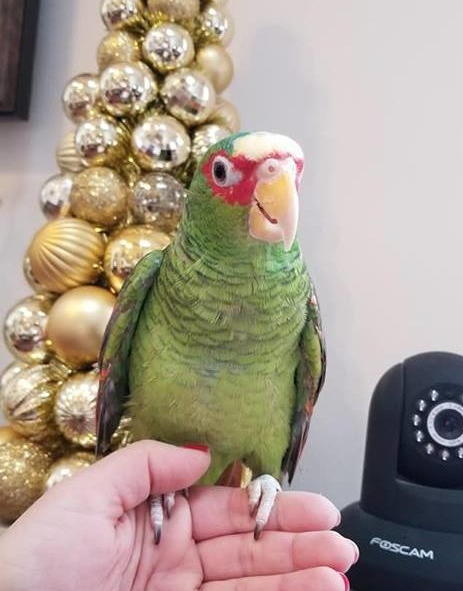
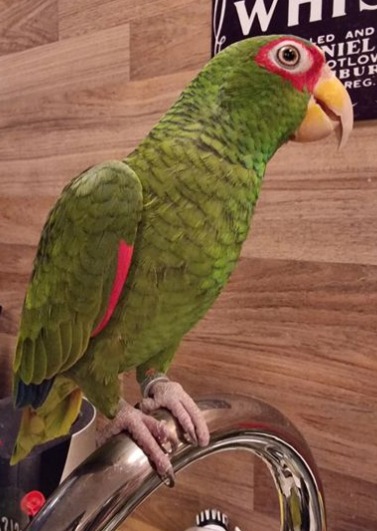
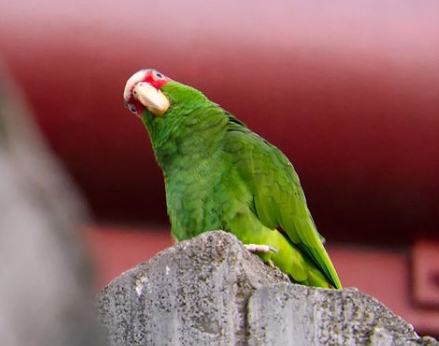
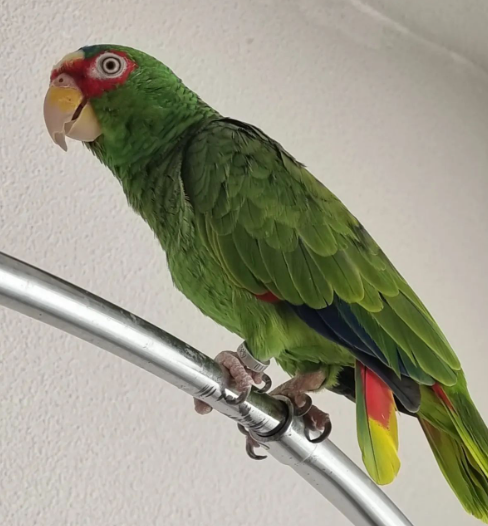
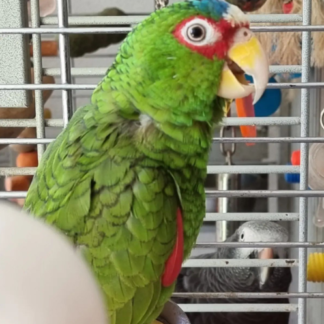
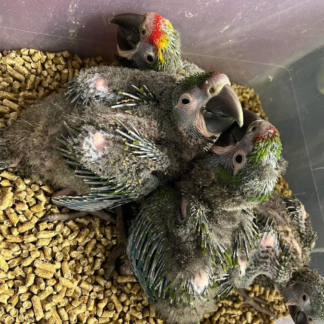


Reviews
There are no reviews yet.